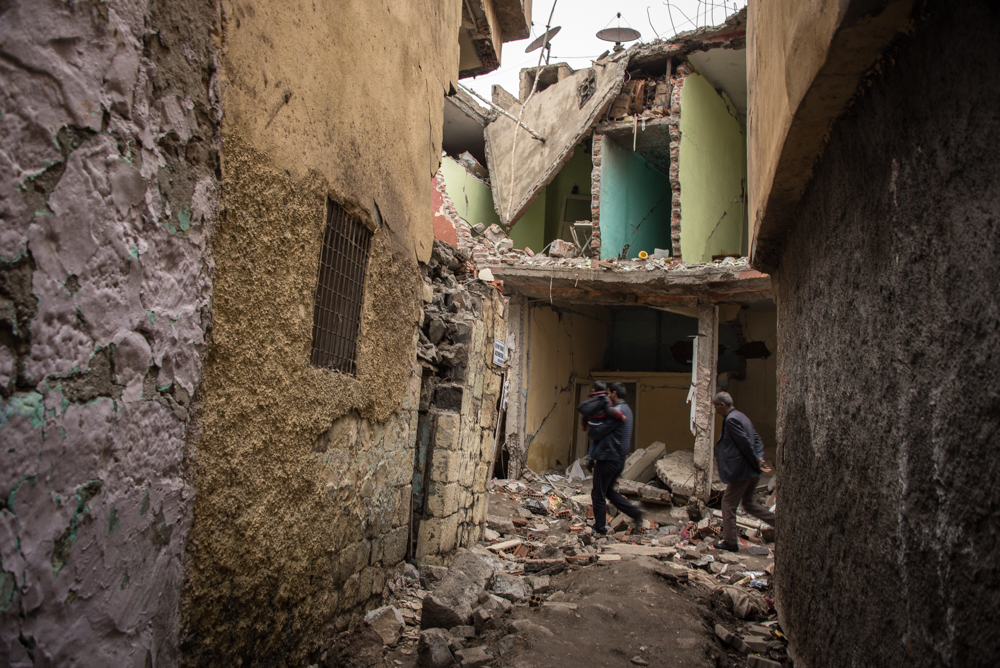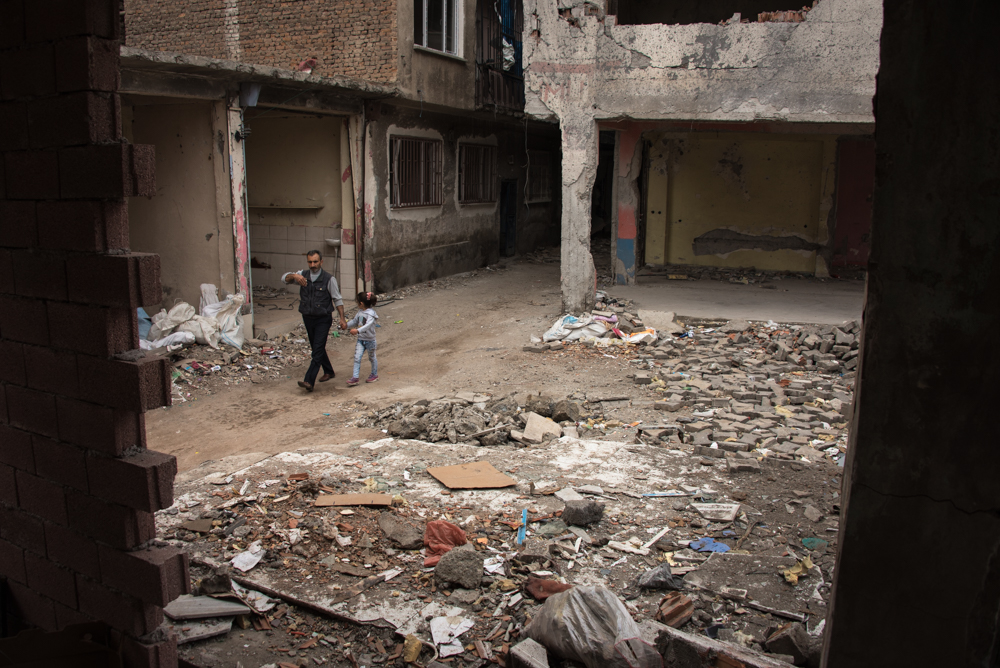Turkey’s Covert War
MIDDLE EAST AND NORTH AFRICA, 28 Mar 2016
Diego Cupolo – Jacobin Magazine
A dispatch from Diyarbakır, Turkey, where Erdoğan continues his military assault on the Kurdish resistance.
25 Mar 2016 – In Diyarbakır, Turkey, large pieces of white tarp hang vertically in the alleys, blocking the view of anyone trying to peer inside. In front of them, police with automatic rifles stand between sandbag barricades, denying entrance to civilians, as much of the city’s central district remains under curfew.
Still, if one waits, the occasional gust of wind will sway the plastic sheets just enough to glimpse the burned-out buildings and storefronts sprayed with bullet holes that lay behind.
This is the Turkish state’s cheapest way to cover up the months-long war it has been waging on Kurdish fighters in the nation’s southeast. More advanced forms of censorship involve detaining academics, denying media access, deporting foreign journalists, and much worse.
The tactics have effectively limited coverage of a war conducted largely outside of international law. Locals tell stories of bodies being left in the street so long that dogs and cats begin to feed on them, of tanks entering residential neighborhoods and firing indiscriminately at houses, and of deceased women being found stripped naked with their breasts cut off.
At the same time, Turkey has signed a deal with the European Union (EU) to stem the flow of refugees arriving in Greece. In exchange for reducing human trafficking and improving living conditions for 2.5 million refugees within its borders, the parties announced last week, Turkey will receive in return: €3 billion in financial aid, the possibility of visa-free travel for its citizens, and a reopening of EU membership talks.
What the implementation process will look like remains unclear. But after enduring more than three months of fighting in Diyarbakır, Kurdish residents see the EU deal as evidence of indifference toward, if not support for, President Recep Tayyip Erdoğan’s ongoing military campaign in the nation’s southeast.
Campaign Strategy
Erdoğan went into Turkey’s June 2015 election hoping for a sweeping victory that would give him enough parliamentary seats to pass major constitutional changes. But a strong showing by the pro-Kurdish People’s Democratic Party (HDP) denied him his coveted super-majority.
Unsatisfied with the results, Erdoğan called a snap election for the fall, and Turkish armed forces launched assaults on militias linked to the Kurdistan Workers’ Party (PKK), who tend to be based in southeastern cities.
The move, which ended a two-and-a-half-year ceasefire in the region, helped the AKP regain its majority in November. But the roots of Erodğan’s actions extend far beyond the most recent elections.
For almost a hundred years, Kurds have been one of the world’s largest groups of stateless people. Nearly half of the globe’s thirty million Kurds live in Turkey (the remaining are divided between Iraq, Syria, and Iran), where they’ve long endured state repression. The Turkish government only officially acknowledged Kurds’ existence in the 1990s; today, Kurds in Turkey continue to face restrictions on their linguistic and cultural heritage, including a ban on public Kurdish-language education.
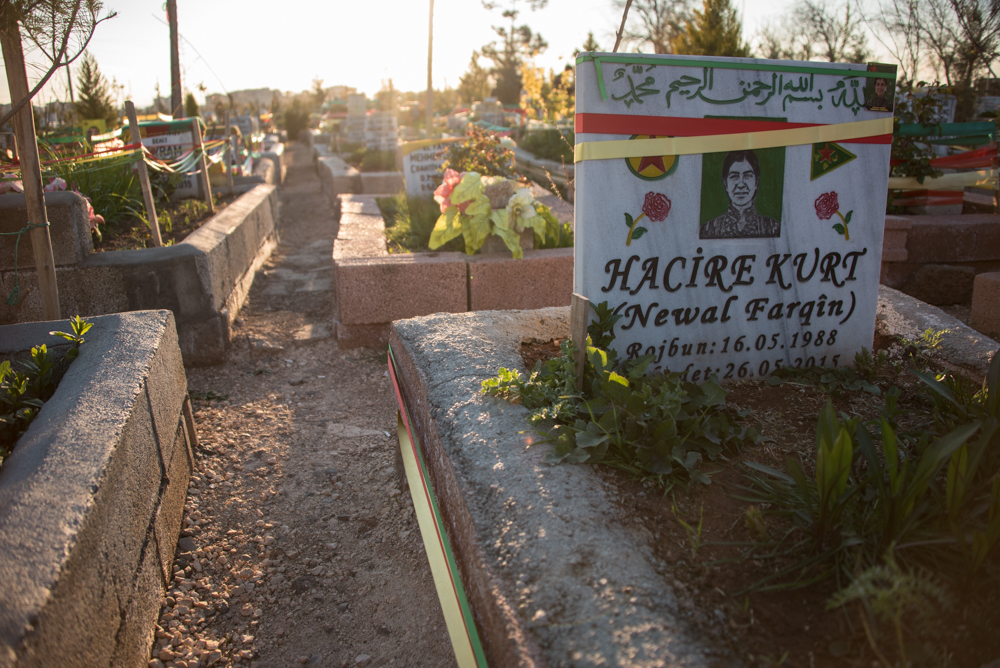
The martyrs’ section of the Diyarbakır cemetery, where fighters from the PKK-linked militias are buried. As their tombstones reveal, most were born in the 1980s and ’90s. Diego Cupolo / Jacobin
Abdullah Öcalan founded the PKK in the late 1970s to counter this subjugation, aiming to expand Kurdish rights through an armed struggle against the Turkish government. Though the militia has fallen short of achieving an independent Kurdish state, it has spurred a significant reawakening among Kurds, who have become more vocal in their demands to be recognized as an ethnic minority in Turkey.
Citizens in Diyarbakır have mixed opinions about the PKK and its loosely affiliated organizations — which have proliferated since the PKK’s rise and Öcalan’s arrest in 1999 — but many tend to look beyond Öcalan’s autocratic faults and identify with the vision for greater autonomy.
More than anything, it is this undying ambition for independence that the Turkish government is fighting.
“If you don’t recognize a central authority, if you want self-governance or autonomy, then you will be destroyed,” says Harun Ercan, international relations advisor for the Peoples’ Democratic Party (HDP), a pro-Kurdish, left-wing formation. “In my opinion, this is the association the Turkish government wants people to make with [the actions they are taking].”
On the Ground in Diyarbakır
On March 9, Turkish forces announced they were ending military operations in Diyarbakır. But two weeks later, fighting continues, and half of the city center remains inaccessible to the public. Gunfire and the occasional explosion ring out in Diyarbakır’s Sur district, and helicopters hover overhead day and night.
Police checkpoints dot the area in and around Sur, a historic district surrounded by UNESCO-listed castle walls that has been the epicenter of urban warfare in Diyarbakır. With winding streets too narrow for tanks and countless alleyways, the old city’s residential areas seem to invite guerilla warfare and place countless civilians in the crossfire. The government says it has lost approximately 275 soldiers in the battles throughout the region, while claiming to have killed at least 500 opposition fighters in Diyarbakır alone.
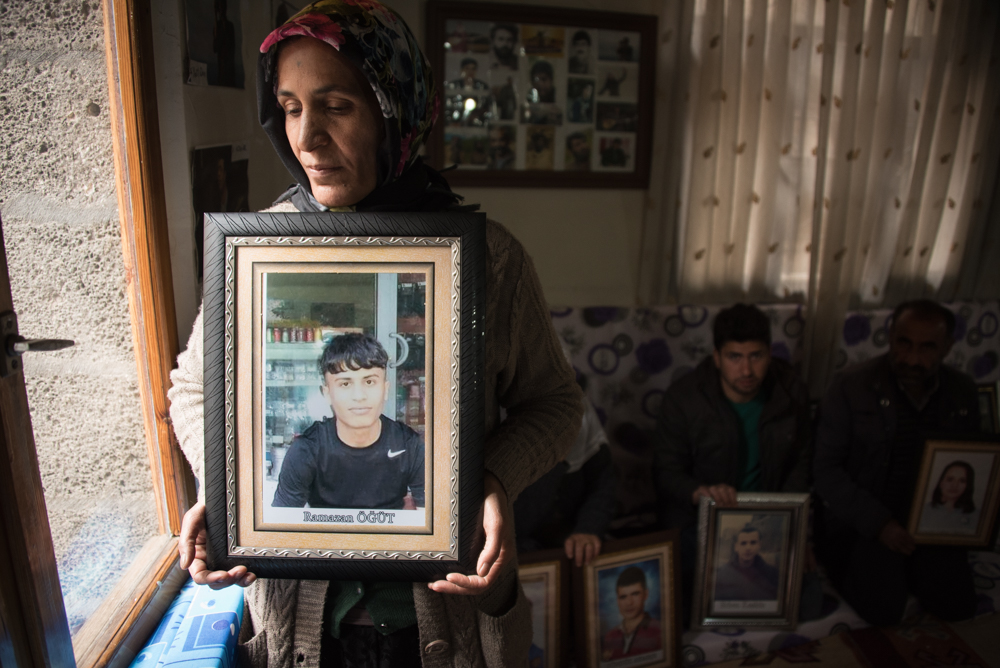
A mother holds the portrait of her missing son in Diyarbakır’s Dicle Firat Cultural Center. Diego Cupolo / Jacobin
At the moment, about forty people are unaccounted for in the city. Their relatives fear they may be buried beneath collapsed buildings or, worse, rotting in the streets. Mothers and fathers of the missing gather daily at the Dicle Firat Cultural Center, where they hold protests begging the government to return the bodies of their sons and daughters, some of whom disappeared more than three months ago.
In conversations with people at the center, one hears similar stories of disappearances without a trace. With vacant eyes, mothers hold framed portraits of their sons as they pose for visiting journalists. Many explain that they have gone to local morgues to identify family members, but the bodies were so mangled and burnt that it was difficult to discern their sex.
Street battles persist in Sur as well as outside the old city walls in the Bağlar district. In addition, the government has announced new curfews and kicked off military campaigns in Yüksekova, Nusaybin, and Şirnak, all predominately Kurdish cities. (Separate military operations are winding down, and curfews are being lifted, in the southeastern cities of Cizre, İdil, Silopi, and Dargeçit.)
If fighting continues, an out-and-out civil war could erupt, creating an entirely new source of refugees.
A Financial Dilemma
Last Friday, European leaders met with Turkish prime minister Ahmet Davutoğlu to finalize the refugee plan.
Observing the deal from Diyarbakır, opposition party members say the government’s mismanagement of the refugee crisis was used to blackmail Europe for financial and political gain.
“The economic instability is increasing every day,” says Ramazan Tunc, an adviser to the Democratic Regions Party, a Kurdish group allied with the HDP. “Foreign investors are turning away from Turkey and exports are [decreasing with] other Middle Eastern countries due to conflicts, so Turkey needs money from the outside to stimulate the economy.”
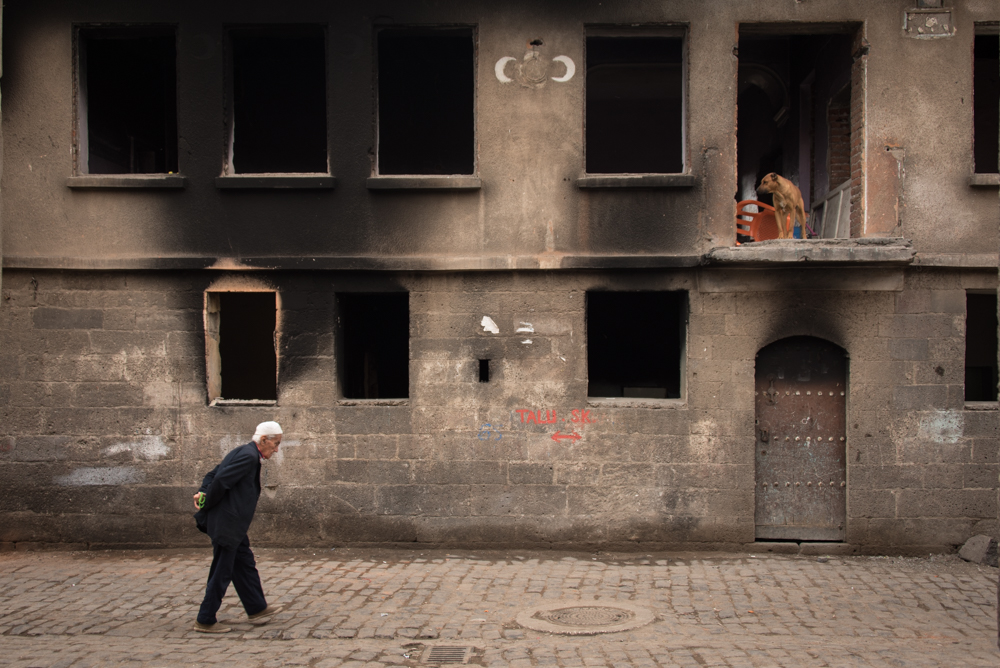
An elderly man walks in front of a burned-out buildings in Diyarbakır’s Sur district. Diego Cupolo / Jacobin
Through much of last year, police in İzmir, a hotbed of smuggling rings, stood idly by as asylum-seekers openly negotiated with smugglers and loaded their bags into vans headed for the Aegean coast. Bright orange life jackets hung in the city’s Basmane district, a marker of the thriving human-trafficking economy.
Only when the potential for EU financial support materialized last fall did Turkish authorities begin to arrest a significant number of the smugglers, at times detaining groups of refugees before they could take off for the Greek islands.
A Moral Dilemma
Back at Diyarbakır’s Dicle Firat Cultural Center, the manager, Mahmut Simsek, consoles grieving families who’ve launched a hunger strike, determined to retrieve the bodies of relatives lost in the clashes.
As the atrocities pile up, Simsek says the Erdoğan government — intent on quashing the Kurdish resistance and possessing a questionable record on refugees, human rights, and press freedoms — is more apt to use the EU funding to finance the ongoing war than to devote it to refugee initiatives.
“This money will come back to us as bombs, as artillery, as new weapons,” he says. “That’s what I believe.”
______________________________________
Diego Cupolo is a photojournalist based in Istanbul.
Go to Original – jacobinmag.com
DISCLAIMER: The statements, views and opinions expressed in pieces republished here are solely those of the authors and do not necessarily represent those of TMS. In accordance with title 17 U.S.C. section 107, this material is distributed without profit to those who have expressed a prior interest in receiving the included information for research and educational purposes. TMS has no affiliation whatsoever with the originator of this article nor is TMS endorsed or sponsored by the originator. “GO TO ORIGINAL” links are provided as a convenience to our readers and allow for verification of authenticity. However, as originating pages are often updated by their originating host sites, the versions posted may not match the versions our readers view when clicking the “GO TO ORIGINAL” links. This site contains copyrighted material the use of which has not always been specifically authorized by the copyright owner. We are making such material available in our efforts to advance understanding of environmental, political, human rights, economic, democracy, scientific, and social justice issues, etc. We believe this constitutes a ‘fair use’ of any such copyrighted material as provided for in section 107 of the US Copyright Law. In accordance with Title 17 U.S.C. Section 107, the material on this site is distributed without profit to those who have expressed a prior interest in receiving the included information for research and educational purposes. For more information go to: http://www.law.cornell.edu/uscode/17/107.shtml. If you wish to use copyrighted material from this site for purposes of your own that go beyond ‘fair use’, you must obtain permission from the copyright owner.
Read more
Click here to go to the current weekly digest or pick another article:
MIDDLE EAST AND NORTH AFRICA:
